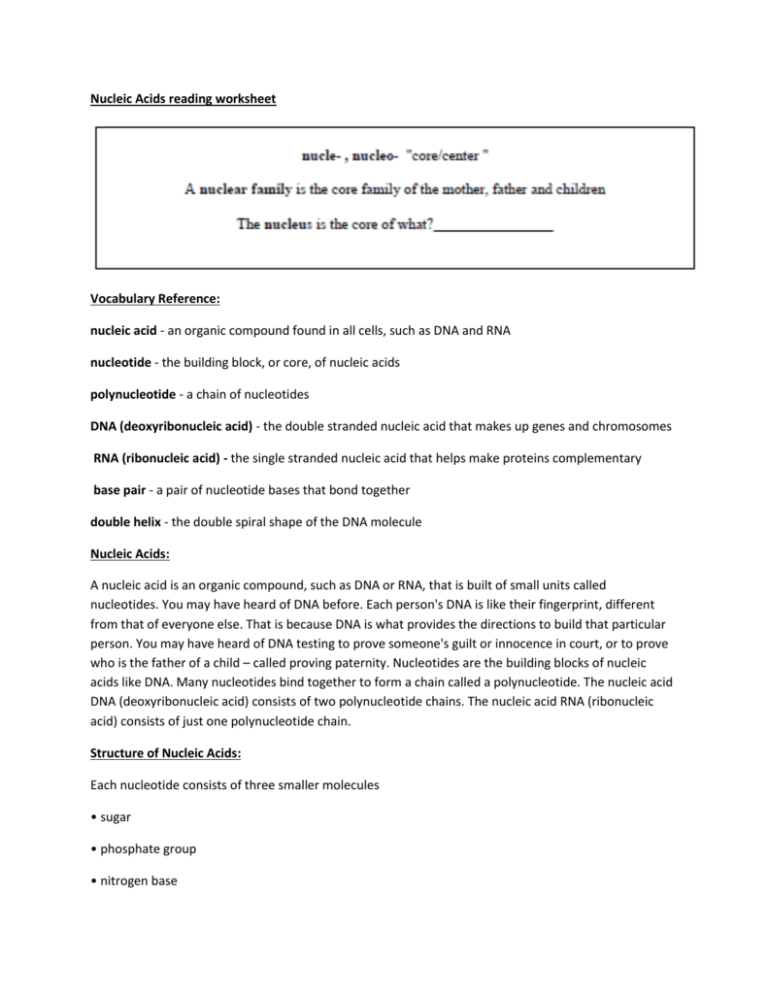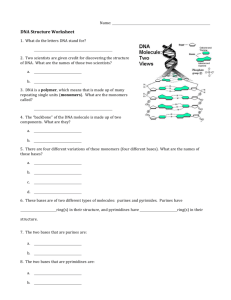Nucleic Acids reading worksheet Vocabulary Reference: nucleic
advertisement

Nucleic Acids reading worksheet Vocabulary Reference: nucleic acid - an organic compound found in all cells, such as DNA and RNA nucleotide - the building block, or core, of nucleic acids polynucleotide - a chain of nucleotides DNA (deoxyribonucleic acid) - the double stranded nucleic acid that makes up genes and chromosomes RNA (ribonucleic acid) - the single stranded nucleic acid that helps make proteins complementary base pair - a pair of nucleotide bases that bond together double helix - the double spiral shape of the DNA molecule Nucleic Acids: A nucleic acid is an organic compound, such as DNA or RNA, that is built of small units called nucleotides. You may have heard of DNA before. Each person's DNA is like their fingerprint, different from that of everyone else. That is because DNA is what provides the directions to build that particular person. You may have heard of DNA testing to prove someone's guilt or innocence in court, or to prove who is the father of a child – called proving paternity. Nucleotides are the building blocks of nucleic acids like DNA. Many nucleotides bind together to form a chain called a polynucleotide. The nucleic acid DNA (deoxyribonucleic acid) consists of two polynucleotide chains. The nucleic acid RNA (ribonucleic acid) consists of just one polynucleotide chain. Structure of Nucleic Acids: Each nucleotide consists of three smaller molecules • sugar • phosphate group • nitrogen base Figure 1.7: Sugars and phosphate groups form the backbone of a polynucleotide chain. Bonds between complementary bases hold two polynucleotide chains together. If you look at Figure 1.7, you will see that the sugar of one nucleotide binds to the phosphate group of the next nucleotide. These two molecules alternate to form the backbone of the nucleotide chain. The nitrogen bases in a nucleic acid stick out from the backbone. There are four different types of bases: cytosine, adenine, guanine, and either thymine (in DNA) or uracil (in RNA). In DNA, bonds form between bases on the two nucleotide chains and hold the chains together. Each type of base binds with just one other type of base: cytosine always binds with guanine, and adenine always binds with thymine. These pairs of bases are called complementary base pairs. The binding of complementary bases allows DNA molecules to take their well-known shape, called a double helix, which is shown in Figure 1.8. A double helix is like two spiral staircases wound around each other. The double helix shape forms naturally and is very strong, making the two polynucleotide chains difficult to break apart. Figure 1.8: Bonds between complementary bases help form the double helix of a DNA molecule. The letters A, T, G, and C stand for the bases adenine, thymine, guanine, and cytosine. The sequence of these four bases in DNA is a code that carries instructions for making proteins. DNA Molecule: Roles of Nucleic Acids: DNA is found in genes, and its sequence of bases makes up a code. Between “starts” and “stops,” the code carries instructions for the correct sequence of amino acids in a protein (see Figure 1.8). RNA uses the information in DNA to assemble the correct amino acids and help make the protein. The information in DNA is passed from parent cells to daughter cells whenever cells divide. The information in DNA is also passed from parents to children when organisms reproduce. This is how inherited characteristics are passed from one generation to the next – from parents to their children. Think – Pair – Share:







